List of 999 women of the Heritage Floor / Margaret Sanger
This list describes the place setting for Margaret Sanger on the table of Judy Chicago's art installation The Dinner Party . It is part of the list of 999 women on the Heritage Floor who are assigned to the respective place settings on the table. The names of the 999 women are on the tiles of the Heritage Floor, which is arranged below the table and belongs to the art installation.
description
The installation consists of a three-sided table, each with 13 historical or mythological personalities, thus a total of 39 people, from prehistory to the women's rights movement . These people were assigned a place setting at the table, consisting of an individually designed table runner, an individually designed plate, a goblet, knife, fork, spoon and serviette. The first page of the table is devoted to prehistory up to the Roman Empire , the second to Christianization up to the Reformation and the third from the American Revolution to the women's movement. Each place setting on the table is assigned additional personalities who have received an entry on the tiles of the Heritage Floor, which occupies the space under the table and the center of the space between the sides of the table. This list captures the personalities assigned to Margaret Sanger's place setting. Your seat is on the third side of the table.
Hints
In addition to the names as they are used in German transcription or in scientific usage, the list shows the spelling chosen by Judy Chicago on the tiles.
The information on women who do not yet have an article in the German-language Wikipedia is referenced by the individual references listed under comments . If individual information in the table is not referenced via the main article, additional individual references are given at the relevant point. If there are any discrepancies between the information provided in Wikipedia articles and the descriptions of the work of art on the Brooklyn Museum website , this will also be indicated under Comments.
Place setting for Margaret Sanger
Margaret Sanger was born on September 14, 1879 in Corning , New York . She worked as a nurse and was women's rights activist , working for birth control and forced sterilization began. She was among the founders of the American Birth Control League , from 1942, the organization Planned Parenthood (dt. Planned Parenthood ) and later the German Pro Familia emerged.
In 1902 she married the Berlin- born architect William Sanger, with whom she had three children. Due to illness and the planned family, she dropped out of her third year training as a nurse shortly before the final exam. The family moved to New York City in 1912 . There she worked in the slums of Manhattan and gave pregnancy and obstetrics on home visits. She encountered a lot of misery, especially among women and shaped by these impressions and the experiences of her mother, who carried 18 pregnancies and finally died of tuberculosis and uterine cancer, she wrote a column for the New York Call newspaper in which she spoke about contraception unwanted pregnancies. She and her husband William also risked imprisonment for distributing a brochure to poor women on the subject. She separated from her husband in 1913 in order to be sexually free. From 1914 on, she sent out the monthly newsletter The Woman Rebel . In it she fought for contraception and the woman's right to her body. An arrest warrant was issued in August 1914 for posting "indecent content". Sanger evaded the warrant by escaping under the pseudonym "Bertha Watson" on the RMS Virginian via Canada to Europe. In London she used her stay for further training and discussed with other sexologists . She also visited the Netherlands , which at the time had the lowest child mortality rate in the world.
After her ex-husband William Sanger spent 30 days in prison in September 1915 for distributing copies of one of her educational pamphlets, she returned to the United States, prepared for trial and imprisonment. The trial was scheduled to start the following January, but their daughter died in November at the age of 5 and public sympathy and pressure from prominent supporters resulted in the trial being canceled. The reason given was that the prosecution was two years old and that they had stopped distributing illegal material. Margaret Sanger made many trips around the country to give birth control lectures. By 1926 she had received over a million letters from women asking for information on birth control. In 1921 she was one of the founders of the American Birth Control League . In 1922 she traveled to Japan to promote birth control together with Shizue Kato . In September of that year she married the widowed oil magnate James Noah Henry Slee, who immigrated to the United States from South Africa. The marriage lasted until his death in 1943.
She opened the first legal birth control clinic in the United States, the Clinical Research Bureau , in 1923. When the first World Population Conference was to take place in Geneva in 1927, Sanger was a member of the organization. She assumed the presidency of the Birth Control International Information Center, and in 1937 became chair of the Birth Control Council of America . At the time, she began publishing The Birth Control Review and The Birth Control News .
In the fall of 1937, she moved to Tucson , Arizona with her sick husband . Her son Stuart also lived in Arizona, and because of his respiratory disease, the dry desert climate improved. She resigned from some of her offices. After her husband died and many of her friends had since died, she moved to a house in Catalina Foothills . So she lived in the immediate vicinity of Stuart, his wife and his two daughters. In the late 1940s she resumed her work in public. In the 1950s she was president of the International Planned Parenthood Federation . She touted the emerging birth control pill in the early 1960s . She died on September 6, 1966 in a nursing home in Tucson, Arizona. On her tombstone is the wrong year of birth. She had made herself younger for four years and was born in 1879 instead of 1883.
The place setting for Margaret Sanger on the dinner party table is designed in strong red tones. They are intended to commemorate the bloodshed of women who died during childbirth or as a result of illegal and unsafe abortions. It also represents the activists' struggle for women's reproductive rights, for which these activists risked arrest and imprisonment. The plate is three-dimensional and the depicted structures of the vulva are blood-red and raised. This is to show how women became more active in their struggles to escape the boundaries of femininity. The table runner was made of pink satin and embroidered with light pink, red and purple tones that match the intense colors of the plate. The table runner shows the butterfly shape, the symbol of the personal freedom of women in the struggle for reproductive choice. The reverse shows the female reproductive system in medical drawings. They reflect the depth and texture of the plate. On the front of the runner is the initial letter "M", which shows a tied mother with her baby. The design is inspired by a quote from Sanger, who said that reproductive freedom would free women from “motherhood in chains”.
| Surname | Spelling on the tile | Date of birth | cultural spatial assignment | Remarks | image |
|---|---|---|---|---|---|
| Agustina de Aragon | Augustina Saragossa | 1786 | Zaragoza | Independence fighter during the Napoleonic occupation . She first fought as a civilian and was later accepted into the Spanish Army. |

|
| Alexandra Mikhailovna Kollontai | Aleksandra Kollantay | 1872 | Russian Empire | Revolutionary , sex politician , diplomat and writer. |

|
| Angelica Balabanova | Angelica Balabanoff | 1878 | Russian Empire | Internationally active socialist politician and publicist. |

|
| Beatrice Webb | Beatrice Webb | 1858 | United Kingdom | Socialist and social reformer , co-founder of the London School of Economics and Political Science , who wrote books on the causes of poverty. |

|
| Catherine Esther Beecher | Catherine Beecher | 1800 | United States | American educator. Known for her outspoken views on women's education and her strong support for the many benefits of including kindergarten in the education of children. |

|
| Clara Zetkin | Clara Zetkin | 1857 | Weimar Republic | Politician, peace activist and women's rights activist. During the Weimar Republic , she was a member of the Reichstag for the KPD from 1920 to 1933 and, in 1932, the age-old president of parliament. |

|
| Dolores Ibárruri | Dolores Ibarruri | 1895 | Basque Country | Revolutionary and politician of the labor movement . |

|
| Dorothea Lynde Dix | Dorothea Dix | 1802 | United States | Benefactress. She initiated reforms in the health system for the mentally ill, first in the United States and later in Europe. During the Civil War , she was put in charge of all hospital nurses in the northern states . |

|
| Eleanor Roosevelt | Eleanor Roosevelt | 1884 | United States | Human rights activist and diplomat and the wife of US President Franklin D. Roosevelt . |

|
| Elizabeth Fry | Elizabeth Fry | 1780 | England | Reformer of the prison system and known as the "angel of prisons". |

|
| Elizabeth Gurley Flynn | Elizabeth Gurley Flynn | 1890 | United States | Labor movement activist and communist politician. |

|
| Ellen Swallow Richards | Ellen Richards | 1842 | United States | Chemist and ecologist . She was one of the founders of "environmental hygiene", the preliminary stage of modern scientific ecology. |

|
| Emma Goldman | Emma Goldman | 1869 | Russian Empire , United States | Anarchist , peace activist, anti-militarist, atheist and feminist theorist. |

|
| Emma Paterson | Emma Paterson | 1848 | United Kingdom | Suffragette. | |
| Federica Montseny | Federica Montseny | 1905 | Second Spanish Republic | Anarchist, intellectual and minister of health during the social revolution that took place in Spain parallel to the civil war. She is also known as a novelist and essayist. |

|
| Frances Perkins | Frances Perkins | 1880 | United States | Politician, was named First Secretary of the United States by Franklin D. Roosevelt . |

|
| Gabrielle Petit | Gabrielle Petit | 1893 | Belgium | During the First World War she spied for the British secret service . In 1916 she was executed by the Germans . After the end of the war she became a Belgian national heroine. |

|
| Golda Meir | Golda Meir | 1898 | Israel | Politician . She was Israel's Foreign Minister from 1956 to 1965 and Prime Minister of Israel from March 17, 1969 to June 3, 1974 . |
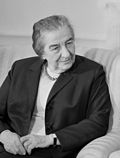
|
| Hannah scenes | Hannah Senesh | 1921 | Hungary | Resistance fighter who jumped with her parachute behind the German front with other Jewish women and men to try to save Jews. |

|
| Helen Keller | Helen Keller | 1880 | United States | Deaf-blind American writer . |

|
| Henrietta Szold | Henrietta Szold | 1860 | United States | Early Zionism activist . She was an educator, author, social worker and in 1912 the founder of the American Zionist women's organization Hadassah . |

|
| Inessa Armand | Inessa Armand | 1874 | France , Soviet Union | Russian revolutionary of French origin. |
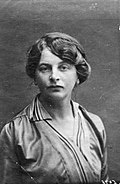
|
| Jane Addams | Jane Addams | 1860 | United States | Feminist , sociologist and committed journalist for the peace movement . In 1931 she received the Nobel Peace Prize together with Nicholas Murray Butler . |

|
| Jeannette Rankin | Jeannette Rankin | 1880 | United States | Politician , women's rights activist and peace activist. She was the first woman to be elected to the United States Congress and House of Representatives there. |
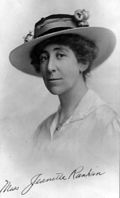
|
| Ekaterina Konstantinovna Brezhko-Brezhkovskaya | Yekaterina Breshkovskaya | 1844 | Russian Empire | Russian socialist revolutionary. |

|
| Katti Anker Møller | Katti Moeler | 1868 | Norway | Women's rights activist, campaigned for the rights of unmarried mothers and illegitimate children. |

|
| Louise Michel | Louise Michel | 1830 | France | Author and anarchist . |

|
| Margaret Mead | Margaret Mead | 1901 | United States | Ethnologist ( cultural anthropologist ) . She is considered one of the most determined representatives of cultural relativism in the 20th century . |

|
| Maria Montessori | Maria Montessori | 1870 | Italy | Doctor , reform pedagogue , philosopher and philanthropist , developed Montessori pedagogy . |
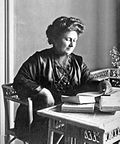
|
| Marie Stopes | Marie Stopes | 1880 | Scotland | Botanist , paleobotanist and author , women's rights activist (" suffragette ") and pioneer in the field of family planning . |

|
| Mary Harris Jones | Mary "Mother" Jones | around 1835 | United States | Leader of the workers and trade union movement . |

|
| Nadezhda Konstantinovna Krupskaya | Nadezhda Krupskaya | 1869 | Russian Empire | Politician, revolutionary, educator and wife of Lenin . |

|
| Rachel Carson | Rachel Carson | 1907 | United States | Zoologist , biologist , science journalist and non-fiction author , whose main work Silent Spring (The Silent Spring) from 1962 is often referred to as the starting point of the US environmental movement . |

|
| Rachel Katznelson-Shazar | Rachel Katznelson | 1885 | Israel | Active personality in the Zionist movement . Her husband was Zalman Shazar , the third President of the State of Israel. |
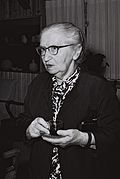
|
| Rosa Luxemburg | Rosa Luxemburg | 1871 | Kingdom of Poland , German Empire | Influential representative of the European labor movement , Marxism , anti-militarism and “ proletarian internationalism ”. |

|
| Ruth Benedict | Ruth Benedict | 1887 | United States | Founder of a comparative cultural anthropology . |

|
| Sofja Lvovna Perovskaya | Sophia Perovskaya | 1853 | Russian Empire | Revolutionary. As a member of Narodnaja Wolja , she was involved in the successful assassination attempt on Tsar Alexander II in March 1881 . She was arrested and executed shortly afterwards. |

|
| Sylvia Ashton-Warner | Sylvia Ashton-Warner | 1908 | New Zealand | Writer, novelist, pedagogue, theorist and painter. | |
| Vera Ivanovna Sassulitsch | Vera Zasulich | 1849 | Russia | Narodnitsa , later a Marxist author and revolutionary . |
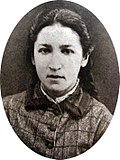
|
| Vera Nikolaevna Figner | Vera Figner | 1852 | Russia | Revolutionary and folk maker . |

|
- Individual evidence
- ^ Brooklyn Museum: Margaret Sanger. In: brooklynmuseum.org. Retrieved November 2, 2019 .
Web links
- Brooklyn Museum, Margaret Sanger
- The Dinner Party on the website of Through the Flower , Judy Chicago's non-profit organization
